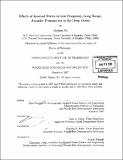Effects of internal waves on low frequency, long range, acoustic propagation in the deep ocean
Author(s)
Xu, Jinshan
DownloadFull printable version (25.66Mb)
Other Contributors
Woods Hole Oceanographic Institution.
Advisor
John A. Colosi and Timothy F. Duda.
Terms of use
Metadata
Show full item recordAbstract
This thesis covers a comprehensive analysis of long-range, deep-ocean, low-frequency, sound propagation experimental results obtained from the North Pacific Ocean. The statistics of acoustic fields after propagation through internal-wave-induced sound-speed fluctuations are explored experimentally and theoretically. The thesis starts with the investigation of the North Pacific Acoustic Laboratory 98-99 data by exploring the space-time scales of ocean sound speed variability and the contributions from different frequency bands. The validity of the Garret & Munk internal-wave model is checked in the upper ocean of the eastern North Pacific. All these results impose hard bounds on the strength and characteristic scales of sound speed fluctuations one might expect in this region of the North Pacific for both internal-wave band fluctuations and mesoscale band fluctuations. The thesis then presents a detailed analysis of the low frequency, broadband sound arrivals obtained in the North Pacific Ocean. The observed acoustic variability is compared with acoustic predictions based on the weak fluctuation theory of Rytov, and direct parabolic equation Monte Carlo simulations. The comparisons show that a resonance condition exists between the local acoustic ray and the internal wave field such that only the internal-waves whose crests are parallel to the local ray path will contribute to acoustic scattering: This effect leads to an important filtering of the acoustic spectra relative to the internal-wave spectra. We believe that this is the first observational evidence for the acoustic ray and internal wave resonance. Finally, the thesis examined the evolution with distance, of the acoustic arrival pattern of the off-axis sound source transmissions in the Long-range Ocean Acoustic Propagation EXperiment. (cont.) The observations of mean intensity time-fronts are compared to the deterministic ray, parabolic equation (with/without internal waves) and (one-way coupled) normal mode calculations. It is found the diffraction effect is dominant in the shorter-range transmission. In the longer range, the (internal wave) scattering effect smears the energy in both the spatial and temporal scales and thus has a dominant role in the finale region.
Description
Thesis (Ph. D.)--Joint Program in Oceanography/Applied Ocean Science and Engineering (Massachusetts Institute of Technology, Dept. of Mechanical Engineering; and the Woods Hole Oceanographic Institution), 2007. Includes bibliographical references (p. 183-191).
Date issued
2007Department
Joint Program in Oceanography/Applied Ocean Science and Engineering; Woods Hole Oceanographic Institution; Massachusetts Institute of Technology. Department of Mechanical EngineeringPublisher
Massachusetts Institute of Technology
Keywords
/Woods Hole Oceanographic Institution. Joint Program in Oceanography/Applied Ocean Science and Engineering., Mechanical Engineering., Woods Hole Oceanographic Institution.